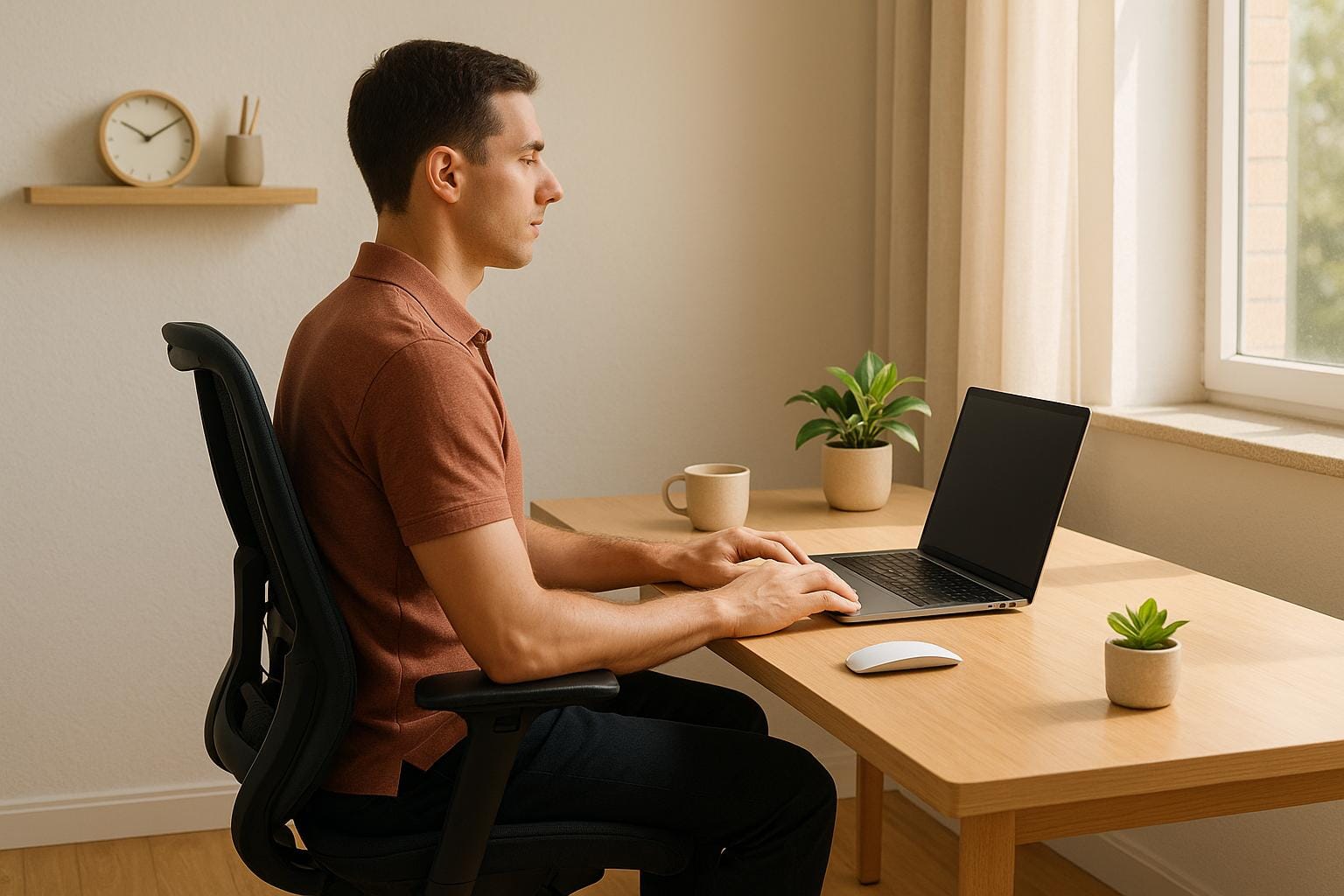Your desk posture impacts your health, productivity, and comfort. Poor posture can lead to back pain, neck strain, and even long-term health problems. Here's a quick breakdown:
- Why it matters: Slouching triples the stress on your neck and can cause headaches, digestive issues, and even shorten your lifespan.
- Health risks: Prolonged sitting increases risks of obesity, diabetes, and cardiovascular issues.
- Fix it: Adjust your workspace - keep your spine neutral, monitor at eye level, and keyboard/mouse at elbow height.
- Move often: Follow the 20-8-2 rule - sit for 20 minutes, stand for 8, and move for 2. Regular stretching also helps.
Good posture isn't just about sitting straight - it's about creating habits that support your body and mind. Keep reading for practical tips to improve your desk setup and daily routine.
7 Easy Ways to Improve Posture at Your Desk - Ask Doctor Jo
How Desk Posture Affects Your Health
Your posture at the desk does more than just influence how you look - it has a profound impact on your overall health. Spending long hours sitting at a desk can subtly but steadily strain your body, leading to health issues that might stick around for the long haul.
How Posture and Body Alignment Work
Your body operates as a finely tuned system, with bones, muscles, and ligaments working together to keep everything functioning smoothly. When your body is aligned correctly, these structures perform efficiently, and your spine retains its natural curves, minimizing unnecessary strain.
Picture your spine as a stack of blocks, perfectly aligned to support your body's weight without tipping over. This alignment reduces stress on your joints and muscles, helping to prevent pain and injuries. Ideally, your head should sit directly above your shoulders, which should in turn align with your hips.
"Proper body alignment can help prevent excess strain on your joints, muscles and spine - alleviating pain and reducing the likelihood of injury. As a bonus, correct posture can boost your productivity and mood, as well as help you use your muscles more efficiently. And starting good habits now can last a lifetime when they are needed most." - Mayo Clinic Staff
Good posture doesn't just prevent discomfort - it can boost your energy, making you feel more active and confident. Standing or sitting tall naturally projects self-assurance, which can positively influence your personal and professional relationships. But when your alignment is off, these benefits quickly fade, and the strain on your body begins to take its toll.
Health Problems from Poor Desk Posture
When your posture slips, your body bears the brunt of the strain. Slouching or hunching at your desk puts extra stress on your back, neck, arms, and legs. Over time, this can lead to more serious issues.
For example, slouching places undue pressure on your spine. It overstretches spinal ligaments and stresses the discs between your vertebrae, which can lead to inflammation, pain, and even long-term problems like disc degeneration or herniation.
Neck pain is another frequent complaint. Did you know that for every inch your head leans forward, your cervical spine takes on an extra 10 pounds of strain? If your head is just two inches out of alignment, that’s an additional 20 pounds your neck muscles are carrying all day long. This is a common issue, with nearly one in three people experiencing neck pain due to poor posture.
"Sitting for prolonged periods of time can be a major cause of back pain, cause increased stress of the back, neck, arms and legs and can add a tremendous amount of pressure to the back muscles and spinal discs." - UCLA Health Spine Center
Poor posture doesn’t just lead to aches and pains. It also creates muscle imbalances, tightness, and reduced blood flow, particularly in the neck, shoulders, and lower back. Among office workers, symptoms like neck (53.5%), lower back (53.2%), and shoulder pain (51.6%) are especially common. Overworked muscles compensate for weaker ones, leading to inefficient oxygen delivery and a greater risk of fatigue and injury.
The risks go beyond your muscles and joints. Prolonged sitting is linked to serious conditions like type 2 diabetes, obesity, coronary artery disease, and even certain cancers. For every two extra hours spent sitting, the risk of obesity rises by 5%, and the risk of diabetes increases by 7%. Over the long term, people who sit most of the day are 1.4 times more likely to face premature death within 12 years compared to those who sit less.
Modern work habits only make matters worse. Office workers typically spend about two-thirds of their workday sitting, and with 35% of U.S. employees now working remotely full-time, many find themselves using poorly designed home office setups. Back in 1960, only 15% of jobs were sedentary, compared to 25% in 2008. Alarmingly, these habits are affecting younger generations too - one in five school-age children now reports back pain.
"It's a common and important health problem among Americans, and it can lead to neck pain, back problems, and other aggravating conditions." - Meghan Markowski, Physical Therapist at Harvard-affiliated Brigham and Women's Hospital
Slouching can also impact your cardiovascular and respiratory systems. Poor posture restricts lung expansion, reducing oxygen intake and potentially affecting blood pressure.
By understanding these risks, it becomes clear why adopting better posture and creating an ergonomic workspace are so critical. Many of these health issues can be avoided or minimized with simple adjustments to how you sit and work.
This article is for informational purposes only and is not intended as medical advice. Please consult a healthcare professional before starting any new fitness or wellness routine.
Basic Rules for Good Desk Posture
When it comes to maintaining a healthy work environment, your desk setup plays a huge role. Poor posture can lead to discomfort, fatigue, and even long-term health issues. Let’s dive into some simple yet effective ways to improve your posture and reduce strain while working.
Neutral Spine and Proper Alignment
The cornerstone of good posture is keeping a neutral spine. This means your spine should maintain its natural curves - neither overly straight nor excessively hunched. A neutral spine helps your muscles work efficiently, preventing unnecessary fatigue and pain.
"When your spine is properly aligned, you benefit from optimum use of your muscles. When your spine is out of alignment, however, your muscles work harder and become fatigued more easily, and this imbalance can lead to muscle and joint pain." - Dr. Kenneth Palmer, Orthopedic Surgeon
Here’s how to achieve proper alignment:
- Sit with your back straight and shoulders relaxed, gently pulled back.
- Align your head with your spine - avoid leaning forward or tilting sideways.
- Keep your feet flat on the floor, with knees bent at a 90-degree angle.
- Relax your shoulders, letting them drop naturally instead of hunching.
This setup not only minimizes strain but also keeps your body in balance throughout the day.
Head, Neck, and Eye Positioning
Your head and neck positioning are just as important as your back alignment. To avoid upper body strain, keep your head in a neutral position, directly above your shoulders.
- Position your monitor so the top of the screen is at or just below eye level. This prevents you from constantly looking up or down.
- Maintain an arm’s length distance (about 20–40 inches) from your screen to reduce neck tension.
- Use a headset if you’re frequently on the phone, rather than cradling it between your ear and shoulder.
Dr. James S. Harrop, Neurosurgeon, emphasizes the risks of poor head positioning:
"If your head is consistently in a downward incline to look at your phone, it affects your back neck muscles, which were not designed to endure this much force for prolonged periods."
Proper screen and document placement can make a world of difference. Keep everything at eye level and within reach to avoid unnecessary bending or twisting.
Common Posture Mistakes to Avoid
Even with the best intentions, it’s easy to fall into bad habits. Here are some common posture mistakes and how to fix them:
| Posture Mistake | Consequences | Solution |
|---|---|---|
| Slouching/Hunching | Spinal disc pressure, muscle imbalance | Sit upright with a neutral spine; use back support. |
| Incorrect Chair Height | Shoulder/neck pain, wrist discomfort | Adjust chair so elbows are at a 90-degree angle. |
| Prolonged Sitting | Muscle stiffness, poor circulation | Stand and move every 30 minutes. |
| Poor Screen Positioning | Neck strain, eye strain | Place monitor at eye level, maintain proper distance. |
| Keyboard/Mouse Placement | Wrist pain, shoulder strain | Keep keyboard and mouse close and at the same height. |
Slouching is one of the most common issues. Over time, it puts extra pressure on your spinal discs and can lead to neck and shoulder discomfort. Similarly, an incorrectly adjusted chair or desk height can strain your shoulders and wrists. Make sure your elbows are bent at a 90-degree angle while typing, with your feet resting flat on the floor.
Another mistake is placing your keyboard and mouse too far away or at the wrong height. Keep them directly in front of you to avoid unnecessary reaching or twisting.
Finally, sitting for long periods - even with perfect posture - can still cause problems. Take breaks to stretch or walk around every 30 minutes. This helps improve circulation and reduces stiffness.
This article is for informational purposes only and is not intended as medical advice. Please consult a healthcare professional before starting any new fitness or wellness routine.
Setting Up Your Workspace for Better Posture
Creating a workspace that supports good posture doesn’t have to be complicated. With a few simple adjustments, you can reduce strain and maintain healthy alignment throughout your workday.
Adjusting Your Chair and Desk
Your chair plays a key role in keeping your posture in check. Start by adjusting the height so your feet rest flat on the floor, with a small gap - about the width of your fist - between the edge of the seat and your calves. If you feel pressure on your thighs, lower the chair; if it’s on your glutes, raise it.
Next, focus on lumbar support. Adjust the backrest to align with the natural curve of your lower back, which helps keep your spine neutral. Armrests should support your elbows at a 90° angle without lifting your shoulders. If they don’t, consider removing them.
For added comfort, tilt your seat slightly forward or keep it neutral. Reclining occasionally can also help relieve pressure on your spine. As Rani Lueder, Founder of Humanics Ergonomics, explains:
"Reclining in a chair is an important way to relieve loads on your spine while opening up your thigh-torso angle, so you should do it throughout the day."
Cornell University suggests a recline of about 110° for tasks like typing or using a mouse. If your legs don’t fit comfortably under the desk, it’s too low; if you’re raising your arms to reach the work surface, it’s too high. Once your seating is set, it’s time to arrange your equipment.
Monitor, Keyboard, and Mouse Placement
The placement of your monitor, keyboard, and mouse is just as important as your chair setup. Position your monitor at eye level and about an arm’s length away. If you use a laptop, consider a stand paired with an external keyboard and mouse to achieve the proper height and angle.
Keep your keyboard and mouse directly in front of you, at elbow height, to avoid shoulder strain. Leave a few inches of space between the keyboard and the desk edge to keep your wrists comfortable. Your forearms should form a 90° angle with your upper arms, and your devices should be aligned with your chair to prevent twisting your body.
While these adjustments cover the basics, ergonomic accessories can take your setup to the next level - if chosen thoughtfully.
Ergonomic Accessories: Pros and Cons
Ergonomic tools can make a big difference, but not all are necessary for every workspace. Studies show that proper ergonomic setups can reduce musculoskeletal issues by up to 60% and improve productivity by 20%. Here’s a breakdown of some common accessories:
| Accessory | Benefits | Drawbacks |
|---|---|---|
| Monitor Arm | Reduces neck strain; optimal height | Can be pricey; requires installation |
| Laptop Riser | Raises screen to eye level | Needs external keyboard and mouse |
| Wrist Rest | Supports neutral wrist position | May feel uncomfortable if too thick |
| Keyboard Drawer | Positions keyboard at the right height | May limit legroom |
| Footrest | Eases leg fatigue; boosts circulation | Not necessary for everyone |
| Sit-Stand Desk | Allows sitting/standing alternation | Expensive; takes up space |
| Anti-Fatigue Mat | Cushions feet; reduces joint stress | Can be a tripping hazard |
For example, monitor arms are great for optimizing screen placement, especially if you use multiple monitors or have limited desk space. Sit-stand desks are another popular option, as alternating positions every 30–60 minutes can improve circulation and reduce fatigue. However, standing for long periods can cause discomfort like swollen ankles, so balance is key.
Ergonomic keyboards and vertical mice are excellent for reducing wrist strain, and a footrest can be a game-changer if raising your chair leaves your feet dangling.
"Ergonomics isn't just about comfort; it's a science dedicated to the understanding and improvement of human interaction with their environment, particularly in the workplace." - Nataliia Borysko, Content Copywriter, Progressive Desk
Finally, don’t overlook the importance of good lighting - around 500–750 lux can help minimize eye strain. Combine these adjustments with regular breaks to stretch and move, and you’ll create a workspace that supports not just your posture but your overall well-being.
This article is for informational purposes only and is not intended as medical advice. Please consult a healthcare professional before starting any new fitness or wellness routine.
Adding Movement and Posture Correction
While setting up an ergonomic workspace is essential, it’s only part of the equation. To truly support your health, you need to incorporate regular movement and posture adjustments into your routine. Even with the best desk setup, sitting still for long periods can strain your body and undo many of the benefits of ergonomics. Regular movement helps reset your posture and ease muscle tension.
Why Movement Breaks Matter
Taking movement breaks isn’t just about feeling more comfortable - it’s a key part of staying healthy and productive. Sitting for extended periods slows your blood circulation, which can lead to swelling and even increase the risk of vascular problems. It also contributes to muscle tightness and discomfort. By taking breaks every 20–30 minutes, you can improve circulation, stay focused, and lower stress levels.
Research confirms the risks of inactivity: it’s an independent factor for vascular disease. Movement breaks don’t just protect your physical health - they also help lift your mood and sharpen your concentration, which can lead to better productivity.
How often should you move? Many people follow the "20-8-2 rule", which involves sitting for 20 minutes, standing for 8 minutes, and moving around for at least 2 minutes.
"Changing posture every 20 to 30 minutes is the most effective strategy to minimize musculoskeletal discomfort and reduce risk of injury." - VIC.GOV.AU
To make this habit stick, try setting reminders on your phone or computer to nudge you toward regular movement. Small actions, like standing during a phone call or walking between meetings, can have a big impact over time.
Next, let’s look at some simple stretches you can do at your desk to fight stiffness and stay comfortable.
Desk Stretches and Exercises
Desk stretches are a simple way to ease stiffness, improve flexibility, and reduce discomfort. In fact, research shows that workplace stretching can cut pain levels by as much as 72 percent.
For desk workers, neck and shoulder stretches are especially effective. Gentle neck rotations, shoulder rolls, and overhead stretches can help release tension in your upper body. To counteract the effects of sitting, try a torso stretch: rotate your upper body to the left and right while keeping your hips steady.
Don’t forget your hips and legs. A hip flexor stretch can be done by stepping one foot back while keeping the other planted firmly. For your hamstrings, extend one leg and reach toward your toes while seated.
When stretching, focus on moving slowly and breathing normally. Avoid bouncing or forcing your body into uncomfortable positions. Stretch only until you feel a gentle pull, never pain. Experts recommend taking 1–3 minutes every 30–45 minutes to move and stretch, which helps ease tension and improve circulation.
Tools and Techniques for Better Posture
Beyond stretching, there are tools and strategies that can help you stay active and improve your posture throughout the day. These solutions are easy to integrate into your workflow.
Break reminder apps are a simple starting point. These apps can send you notifications to take movement breaks, helping you stay consistent. Many productivity tools even allow you to customize break schedules to fit your routine.
If you have access to a flexible standing desk, use it to alternate between sitting and standing during your workday. No standing desk? No problem. You can still find ways to move, like standing during phone calls or taking short walks during breaks.
Posture awareness is another important piece of the puzzle. There’s no such thing as a perfect position to hold all day, so the key is to keep shifting. Changing your posture frequently, varying your tasks, and occasionally focusing on objects in the distance can help reset your alignment and reduce strain.
Ultimately, the goal is to build a routine where movement becomes second nature - a seamless part of your day.
This article is for informational purposes only and is not intended as medical advice. Please consult a healthcare professional before starting any new fitness or wellness routine.
Science-Based Tips from Fitup

At Fitup, we believe that improving posture isn’t just about standing or sitting up straight - it’s about understanding how your body works and building habits that support its natural alignment. Science tells us that lasting posture improvement combines physical adjustments with mindful practices. It’s this balance that helps reduce strain, improve comfort, and support overall wellness.
One of the key principles of good posture is maintaining the natural curves of your spine. When these curves are properly supported, your body can move and function efficiently, easing pressure on your muscles and joints while even aiding better breathing.
Long-Term Strategies for Better Posture
Developing better posture habits takes time and a well-rounded approach. Strengthening and stretching specific muscle groups - like those in your upper back, chest, and core - is a critical first step. By addressing these areas, you can gradually correct poor posture and build a stronger foundation for your spine.
Core exercises, such as planks and crunches, are particularly effective in creating the support your spine needs to stay aligned. Beyond targeted exercises, activities like yoga and tai chi can improve your body awareness and strengthen your core. These practices help you identify proper alignment and develop the muscle memory necessary for lasting changes.
Weight management also plays a surprisingly important role in posture health. Carrying extra weight, especially around your midsection, can strain your back and pull your spine out of alignment. Maintaining a healthy weight can prevent these issues and support your posture over time.
Another exciting tool in posture improvement is the use of smart posture trainers. These devices provide real-time feedback, alerting you when you’re slouching or misaligned. Clinical studies have shown that users can see improvements in just 14 days with consistent use. These tools are a helpful way to reinforce proper posture habits throughout your day.
Consistency is everything. Regular posture checks and taking movement breaks can gradually retrain your body’s default position, helping you maintain alignment without constant effort.
Wellness Practices That Support Good Posture
Physical adjustments alone aren’t enough - mindful practices can also play a powerful role in improving posture. Mindfulness techniques, for example, can help you become aware of your body’s position and notice when you’re slipping out of alignment. Breathing exercises, in particular, can reduce tension and naturally encourage better posture.
Stretching routines are another essential component. Regular stretching increases flexibility and eases muscle tension, both of which are crucial for maintaining proper alignment. Dedicating time to targeted stretches can also help correct deeper imbalances caused by long hours of sitting.
As Astrid DiVincent, a physical therapist at HSS, explains, “Our body’s position and alignment significantly impact the way we feel”. Improving your posture doesn’t just reduce pain - it can also boost your energy, confidence, and mood. DiVincent also reminds us, “No posture is good for too long a period of time”, emphasizing the importance of frequent movement and position changes during the day.
Even simple lifestyle choices, like wearing supportive shoes, can make a difference. Avoiding high heels and opting for comfortable footwear helps maintain balance and supports your posture from the ground up.
The research is clear: improving posture requires a blend of physical effort, mindfulness, and consistent movement. By incorporating these strategies into your daily routine, you can create lasting changes that not only enhance your posture but also improve your overall well-being.
This article is for informational purposes only and is not intended as medical advice. Please consult a healthcare professional before starting any new fitness or wellness routine.
Key Takeaways for Maintaining Desk Posture
Good desk posture goes beyond just sitting up straight - it’s about building habits that support your health over time. Studies indicate that poor posture can contribute to musculoskeletal issues and chronic pain.
Set Up Your Workspace for Success. Your chair and desk layout are crucial for maintaining proper posture. Start by positioning your monitor at eye level, roughly an arm's length away. Adjust your desk so your elbows form a 90-degree angle while typing. An ergonomic chair with good lower back support is ideal, but if that’s not an option, a folded towel placed behind your lower back can help preserve your spine’s natural curve.
Keep Your Body Aligned. Once your workspace is set, focus on your posture. Sit with your back flat against the chair, shoulders relaxed and slightly back, and feet flat on the floor. Keep your wrists straight while typing, and position your keyboard and mouse so your elbows stay close to your body.
Incorporate Regular Movement. Use the 20-8-2 rule to break up long periods of sitting: every 30 minutes, sit for 20 minutes, stand for 8 minutes, and move around for 2 minutes. To reduce eye strain, follow the 20-20-20 rule - every 20 minutes, look at something 20 feet away for 20 seconds. These small adjustments can make a big difference in staying comfortable and aligned throughout the day.
Check Your Posture Often. Take a moment throughout the day to realign yourself. Place your feet flat on the floor, tuck your chin slightly, and gently pull your shoulder blades together. Adding quick shoulder stretches can help ease tension and combat slouching.
Engage Your Entire Body. Avoid crossing your legs while sitting; instead, keep your feet flat and move them periodically to improve circulation. Regularly stretch and strengthen your hips, glutes, and hamstrings, and pay attention to any discomfort in your back, shoulders, or neck.
The secret to improving desk posture is consistency. Physical therapist Astrid DiVincent from HSS emphasizes:
"No posture is good for too long a period of time. You may have the best ergonomic situation possible, but if you sit at your desk for 10 hours a day, you're going to have pain".
By combining movement, proper workstation setup, and frequent posture checks, you can create a more comfortable and sustainable routine.
This article is for informational purposes only and is not intended as medical advice. Please consult a healthcare professional before starting any new fitness or wellness routine.
FAQs
What are the signs that my desk posture is affecting my health?
Poor desk posture can cause a range of health problems. You might notice neck, back, or shoulder pain that doesn’t seem to go away, along with stiffness, frequent headaches, or even a tingling or numb sensation in your arms or legs. These could be signs of muscle strain or nerve compression.
Other red flags include feeling unusually tired, struggling to maintain balance, or even shallow breathing. All of these can be tied to poor posture at your desk. If these issues keep cropping up, it’s worth taking a closer look at your workspace and making changes to promote better posture and improve your overall comfort.
How can I set up an ergonomic home workspace to maintain good posture?
Creating a comfortable and ergonomic home workspace can do wonders for your posture and help you avoid unnecessary aches and pains. Start by adjusting your chair so that your feet rest flat - either on the floor or a footrest - while keeping your thighs parallel to the ground. Make sure your lower back gets proper support, whether that’s from a chair designed with lumbar support or by adding a cushion.
Next, set up your monitor at eye level and around an arm's length away. This helps reduce neck strain and prevents eye fatigue. When it comes to your keyboard and mouse, keep them close to your body and position your elbows at a 90-degree angle. To avoid wrist strain, try not to rest your wrists on the desk while typing.
Finally, pick a spot that’s well-lit and free from distractions to help you stay focused and comfortable while working. These small tweaks can significantly improve your posture and make your workday much more pleasant.
How often should I take breaks from sitting to stay healthy at my desk?
To counteract the downsides of sitting for long stretches, try to get up and move every 30 minutes. Even a brief 5-minute walk or some stretching can help get your blood flowing, ease stiffness, and give you a much-needed energy boost. Staying active throughout the day is essential for keeping both your body and mind in good shape, especially during those marathon work sessions.












